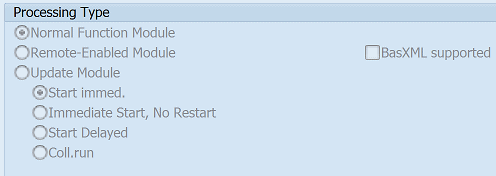SAP DATE_STRING_CONVERT Function Module for Conversion of Relative or Abbreviated Date Specification
DATE_STRING_CONVERT is a standard date string convert SAP function module available within SAP R/3 or S/4 Hana systems, depending on your version and release level. It is used for Conversion of Relative or Abbreviated Date Specification processing and below is the pattern details for this FM, showing its interface including any import and export parameters, exceptions etc. there is also a full "cut and paste" ABAP pattern code example, along with implementation ABAP coding, documentation and contribution comments specific to this or related objects.
See here to view full function module documentation and code listing for date string convert FM, simply by entering the name DATE_STRING_CONVERT into the relevant SAP transaction such as SE37 or SE38.
Function Group: TB01_ADDON
Program Name: SAPLTB01_ADDON
Main Program: SAPLTB01_ADDON
Appliation area: F
Release date: N/A
Mode(Normal, Remote etc): Normal Function Module
Update:

Function DATE_STRING_CONVERT pattern details
In-order to call this FM within your sap programs, simply using the below ABAP pattern details to trigger the function call...or see the full ABAP code listing at the end of this article. You can simply cut and paste this code into your ABAP progrom as it is, including variable declarations.CALL FUNCTION 'DATE_STRING_CONVERT'"Conversion of Relative or Abbreviated Date Specification.
EXPORTING
DATE_FORMAT = "Datumsdarstellung des Benutzers
DATE_STRING = "Datumsstring (relativ oder abgekürzt)
* START_DATE = SY-DATUM "Baseline Date
IMPORTING
RESULT_DATE = "Result Date
IMPORTING Parameters details for DATE_STRING_CONVERT
DATE_FORMAT - Datumsdarstellung des Benutzers
Data type: USR01-DATFMOptional: No
Call by Reference: No ( called with pass by value option)
DATE_STRING - Datumsstring (relativ oder abgekürzt)
Data type:Optional: No
Call by Reference: No ( called with pass by value option)
START_DATE - Baseline Date
Data type: SY-DATUMDefault: SY-DATUM
Optional: Yes
Call by Reference: No ( called with pass by value option)
EXPORTING Parameters details for DATE_STRING_CONVERT
RESULT_DATE - Result Date
Data type: SY-DATUMOptional: No
Call by Reference: No ( called with pass by value option)
Copy and paste ABAP code example for DATE_STRING_CONVERT Function Module
The ABAP code below is a full code listing to execute function module POPUP_TO_CONFIRM including all data declarations. The code uses the original data declarations rather than the latest in-line data DECLARATION SYNTAX but I have included an ABAP code snippet at the end to show how declarations would look using the newer method of declaring data variables on the fly. This will allow you to compare and fully understand the new inline method. Please note some of the newer syntax such as the @DATA is not available until a later 4.70 service pack (SP8), which i why i have stuck to the origianl for this example.| DATA: | ||||
| lv_date_format | TYPE USR01-DATFM, " | |||
| lv_result_date | TYPE SY-DATUM, " | |||
| lv_date_string | TYPE SY, " | |||
| lv_start_date | TYPE SY-DATUM. " SY-DATUM |
| CALL FUNCTION 'DATE_STRING_CONVERT' "Conversion of Relative or Abbreviated Date Specification |
| EXPORTING | ||
| DATE_FORMAT | = lv_date_format | |
| DATE_STRING | = lv_date_string | |
| START_DATE | = lv_start_date | |
| IMPORTING | ||
| RESULT_DATE | = lv_result_date | |
| . " DATE_STRING_CONVERT | ||
ABAP code using 7.40 inline data declarations to call FM DATE_STRING_CONVERT
The below ABAP code uses the newer in-line data declarations. This allows you to see the coding differences/benefits of the later inline syntax. Please note some of the newer syntax below, such as the @DATA is not available until 4.70 EHP 8.| "SELECT single DATFM FROM USR01 INTO @DATA(ld_date_format). | ||||
| "SELECT single DATUM FROM SY INTO @DATA(ld_result_date). | ||||
| "SELECT single DATUM FROM SY INTO @DATA(ld_start_date). | ||||
| DATA(ld_start_date) | = SY-DATUM. | |||
Search for further information about these or an SAP related objects